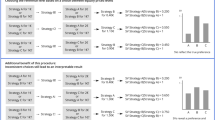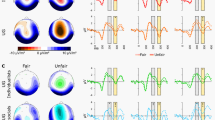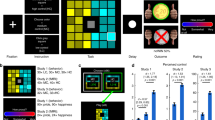Abstract
People make decisions based on deviations from expected outcomes, known as prediction errors. Past work has focused on reward prediction errors, largely ignoring violations of expected emotional experiences—emotion prediction errors. We leverage a method to measure real-time fluctuations in emotion as people decide to punish or forgive others. Across four studies (N = 1,016), we reveal that emotion and reward prediction errors have distinguishable contributions to choice, such that emotion prediction errors exert the strongest impact during decision-making. We additionally find that a choice to punish or forgive can be decoded in less than a second from an evolving emotional response, suggesting that emotions swiftly influence choice. Finally, individuals reporting significant levels of depression exhibit selective impairments in using emotion—but not reward—prediction errors. Evidence for emotion prediction errors potently guiding social behaviours challenge standard decision-making models that have focused solely on reward.
This is a preview of subscription content, access via your institution
Access options
Access Nature and 54 other Nature Portfolio journals
Get Nature+, our best-value online-access subscription
$29.99 / 30 days
cancel any time
Subscribe to this journal
Receive 12 digital issues and online access to articles
$119.00 per year
only $9.92 per issue
Buy this article
- Purchase on Springer Link
- Instant access to full article PDF
Prices may be subject to local taxes which are calculated during checkout




Similar content being viewed by others
Data availability
Experiment materials information and all experiment de-identified data are publicly available at https://github.com/jpheffne/epe. The materials used in this study are widely available.
Code availability
Data analysis script notebooks are publicly available at https://github.com/jpheffne/epe.
References
Schultz, W., Dayan, P. & Montague, P. R. A neural substrate of prediction and reward. Science 275, 1593–1599 (1997).
Schultz, W. & Dickinson, A. Neuronal coding of prediction errors. Annu. Rev. Neurosci. 23, 473–500 (2000).
King-Casas, B. et al. Getting to know you: reputation and trust in a two-person economic exchange. Science 308, 78–83 (2005).
Pessiglione, M., Seymour, B., Flandin, G., Dolan, R. J. & Frith, C. D. Dopamine-dependent prediction errors underpin reward-seeking behaviour in humans. Nature 442, 1042–1045 (2006).
Sutton, R. S. & Barto, A. G. Introduction to Reinforcement Learning (MIT Press, 1998).
Ruff, C. C. & Fehr, E. The neurobiology of rewards and values in social decision making. Nat. Rev. Neurosci. 15, 549–562 (2014).
Ho, M. K., MacGlashan, J., Littman, M. L. & Cushman, F. Social is special: a normative framework for teaching with and learning from evaluative feedback. Cognition 167, 91–106 (2017).
Bechara, A., Damasio, H., Tranel, D. & Damasio, A. R. Deciding advantageously before knowing the advantageous strategy. Science 275, 1293–1295 (1997).
Dalgleish, T. The emotional brain. Nat. Rev. Neurosci. 5, 583–589 (2004).
Vuilleumier, P. How brains beware: neural mechanisms of emotional attention. Trends Cogn. Sci. 9, 585–594 (2005).
Phelps, E. A., Lempert, K. M. & Sokol-Hessner, P. Emotion and decision making: multiple modulatory neural circuits. Annu. Rev. Neurosci. 37, 263–287 (2014).
Phelps, E. A. Emotion and cognition: insights from studies of the human amygdala. Annu. Rev. Psychol. 57, 27–53 (2006).
Richard, R., van der Pligt, J. & de Vries, N. Anticipated affect and behavioral choice. Basic Appl. Soc. Psychol. 18, 111–129 (1996).
Caplin, A. & Leahy, J. Psychological expected utility theory and anticipatory feelings. Q. J. Econ. 116, 55–79 (2001).
Knutson, B. & Greer, S. M. Anticipatory affect: neural correlates and consequences for choice. Philos. Trans. R. Soc. B 363, 3771–3786 (2008).
Nielsen, L., Knutson, B. & Carstensen, L. L. Affect dynamics, affective forecasting, and aging. Emotion 8, 318–330 (2008).
Mellers, B. A. & McGraw, A. P. Anticipated emotions as guides to choice. Curr. Dir. Psychol. Sci. 10, 210–214 (2001).
Mellers, B., Schwartz, A. & Ritov, I. Emotion-based choice. J. Exp. Psychol. Gen. 128, 332–345 (1999).
Feldmanhall, O. & Chang, L. J. in Goal-Directed Decision Making (eds Morris R., Bornstein A. & Shenhav A.) Ch. 14, 309–330 (Academic, 2018).
Xiang, T., Lohrenz, T. & Montague, P. R. Computational substrates of norms and their violations during social exchange. J. Neurosci. 33, 1099 (2013).
Hétu, S., Luo, Y., D’Ardenne, K., Lohrenz, T. & Montague, P. R. Human substantia nigra and ventral tegmental area involvement in computing social error signals during the ultimatum game. Soc. Cogn. Affect. Neurosci. 12, 1972–1982 (2017).
Thornton, M. A. & Tamir, D. I. Mental models accurately predict emotion transitions. Proc. Natl Acad. Sci. USA 114, 5982 (2017).
Chang, L. & Sanfey, A. Unforgettable ultimatums? Expectation violations promote enhanced social memory following economic bargaining. Front. Behav. Neurosci. 3, 36 (2009).
Chang, L. J. & Sanfey, A. G. Great expectations: neural computations underlying the use of social norms in decision-making. Soc. Cogn. Affect. Neurosci. 8, 277–284 (2011).
Loewenstein, G. & Lerner, J. S. in Handbook of Affective Sciences. Series in Affective Science (eds Davidson, R. J., Scherer, K. R. & Hill Goldsmith H.) 619–642 (Oxford Univ. Press, 2003).
Chang, L. J. & Eshin, J. in The Nature of Emotion: Fundamental Questions (eds Fox A. S., Lapate R. C., Shackman A. J. & Davidson R. J.) (Oxford Univ. Press, 2018).
Hartley, C. & Sokol-Hessner, P. in The Nature of Emotion: Fundamental Questions (eds Fox A. S., Lapate R. C., Shackman A. J. & Davidson R. J.) (Oxford Univ. Press, 2017).
Sanfey, A. G. Social decision-making: Insights from game theory and neuroscience. Science 318, 598–602 (2007).
Pessoa, L. How do emotion and motivation direct executive control? Trends Cogn. Sci. 13, 160–166 (2009).
O’Doherty, J., Kringelbach, M. L., Rolls, E. T., Hornak, J. & Andrews, C. Abstract reward and punishment representations in the human orbitofrontal cortex. Nat. Neurosci. 4, 95 (2001).
Dolan, R. J. Emotion, cognition, and behavior. Science 298, 1191–1194 (2002).
Juechems, K. & Summerfield, C. Where does value come from? Trends Cogn. Sci. 23, 836–850 (2019).
Kahneman, D. & Tversky, A. Prospect theory: an analysis of decision under risk. Econometrica 47, 263–291 (1979).
Ironside, M. et al. Approach-avoidance conflict in major depression: congruent neural findings in human and non-human primates. Biol. Psychiatry https://doi.org/10.1016/j.biopsych.2019.08.022 (2019).
Treadway, M. T. & Zald, D. H. Parsing anhedonia: translational models of reward-processing deficits in psychopathology. Curr. Dir. Psychol. Sci. 22, 244–249 (2013).
Whitton, A. E., Treadway, M. T. & Pizzagalli, D. A. Reward processing dysfunction in major depression, bipolar disorder and schizophrenia. Curr. Opin. Psychiatry 28, 7–12 (2015).
Hooker, C. & Park, S. Emotion processing and its relationship to social functioning in schizophrenia patients. Psychiatry Res. 112, 41–50 (2002).
Pessoa, L. On the relationship between emotion and cognition. Nat. Rev. Neurosci. 9, 148–158 (2008).
Berridge, K. C. The debate over dopamine’s role in reward: the case for incentive salience. Psychopharmacology 191, 391–431 (2007).
Berridge, K. C., Robinson, T. E. & Aldridge, J. W. Dissecting components of reward: ‘liking’, ‘wanting’, and learning. Curr. Opin. Pharmacol. 9, 65–73 (2009).
Russell, J. A. Core affect and the psychological construction of emotion. Psychol. Rev. 110, 145–172 (2003).
Russell, J. A. & Barrett, L. F. Core affect, prototypical emotional episodes, and other things called emotion: dissecting the elephant. J. Pers. Soc. Psychol. 76, 805–819 (1999).
Russell, J. A., Weiss, A. & Mendelsohn, G. A. Affect grid: a single-item scale of pleasure and arousal. J. Pers. Soc. Psychol. 57, 493–502 (1989).
Dayan, P. & Daw, N. D. Decision theory, reinforcement learning, and the brain. Cogn. Affect. Behav. Neurosci. 8, 429–453 (2008).
Berridge, K. C. From prediction error to incentive salience: mesolimbic computation of reward motivation. Eur. J. Neurosci. 35, 1124–1143 (2012).
Kaelbling, L. P., Littman, M. L. & Moore, A. W. Reinforcement learning: a survey. J. Artif. Int. Res. 4, 237–285 (1996).
Montague, P. R., Dayan, P. & Sejnowski, T. J. A framework for mesencephalic dopamine systems based on predictive Hebbian learning. J. Neurosci. 16, 1936 (1996).
Daw, N. D., Niv, Y. & Dayan, P. Uncertainty-based competition between prefrontal and dorsolateral striatal systems for behavioral control. Nat. Neurosci. 8, 1704–1711 (2005).
Levy, D. J. & Glimcher, P. W. The root of all value: a neural common currency for choice. Curr. Opin. Neurobiol. 22, 1027–1038 (2012).
Güth, W., Schmittberger, R. & Schwarze, B. An experimental analysis of ultimatum bargaining. J. Econ. Behav. Organ. 3, 367–388 (1982).
FeldmanHall, O., Sokol-Hessner, P., Van Bavel, J. J. & Phelps, E. A. Fairness violations elicit greater punishment on behalf of another than for oneself. Nat. Commun. 5, 5306 (2014).
Rutledge, R. B., Skandali, N., Dayan, P. & Dolan, R. J. A computational and neural model of momentary subjective well-being. Proc. Natl Acad. Sci. USA 111, 12252 (2014).
Aiken, L. S. & West, S. G. in Multiple Regression: Testing and Interpreting Interactions (eds Aiken, L. S. & West, S. G.) Ch. XI, 212 (Sage, 1991).
Iacobucci, D., Schneider, M. J., Popovich, D. L. & Bakamitsos, G. A. Mean centering helps alleviate “micro” but not “macro” multicollinearity. Behav. Res. Methods 48, 1308–1317 (2016).
Delgado, M. R., Locke, H. M., Stenger, V. A. & Fiez, J. A. Dorsal striatum responses to reward and punishment: effects of valence and magnitude manipulations. Cogn. Affect. Behav. Neurosci. 3, 27–38 (2003).
Murray, E. A. The amygdala, reward and emotion. Trends Cogn. Sci. 11, 489–497 (2007).
Lang, P. J. & Bradley, M. M. in Handbook of Approach and Avoidance Motivation (ed. Elliot A. J.) 51–65 (Psychology, 2008).
Clogg, C. C., Petkova, E. & Haritou, A. Statistical methods for comparing regression coefficients between models. Am. J. Sociol. 100, 1261–1293 (1995).
Sokol-Hessner, P. et al. Thinking like a trader selectively reduces individuals’ loss aversion. Proc. Natl Acad. Sci. USA 106, 5035 (2009).
Montague, P. R. & Lohrenz, T. To detect and correct: norm violations and their enforcement. Neuron 56, 14–18 (2007).
Sanfey, A. G., Rilling, J. K., Aronson, J. A., Nystrom, L. E. & Cohen, J. D. The neural basis of economic decision-making in the Ultimatum Game. Science 300, 1755–1758 (2003).
Scherer, K. R. Emotions are emergent processes: they require a dynamic computational architecture. Philos. Trans. R. Soc. B 364, 3459–3474 (2009).
Diener, E., Larsen, R. J., Levine, S. & Emmons, R. A. Intensity and frequency: dimensions underlying positive and negative affect. J. Pers. Soc. Psychol. 48, 1253–1265 (1985).
Kuppens, P., Oravecz, Z. & Tuerlinckx, F. Feelings change: accounting for individual differences in the temporal dynamics of affect. J. Pers. Soc. Psychol. 99, 1042–1060 (2010).
Freeman, J. B. & Ambady, N. MouseTracker: software for studying real-time mental processing using a computer mouse-tracking method. Behav. Res. Methods 42, 226–241 (2010).
Admon, R. & Pizzagalli, D. A. Dysfunctional reward processing in depression. Curr. Opin. Psychol. 4, 114–118 (2015).
Keren, H. et al. Reward processing in depression: a conceptual and meta-analytic review across fMRI and EEG studies. Am. J. Psychiatry 175, 1111–1120 (2018).
Dowd, E. C., Frank, M. J., Collins, A., Gold, J. M. & Barch, D. M. Probabilistic reinforcement learning in patients with schizophrenia: relationships to anhedonia and avolition. Biol. Psychiatry. Cogn. Neurosci. Neuroimaging 1, 460–473 (2016).
Radloff, L. S. The CES-D Scale: A self-report depression scale for research in the general population. Appl. Psychol. Measure. 1, 385–401 (1977).
Moutoussis, M. et al. Neural activity and fundamental learning, motivated by monetary loss and reward, are intact in mild to moderate major depressive disorder. PLoS ONE 13, e0201451 (2018).
Demiralp, E. et al. Feeling blue or turquoise? Emotional differentiation in major depressive disorder. Psychol. Sci. 23, 1410–1416 (2012).
Lindquist, K. A. & Barrett, L. F. in Handbook of Emotions (ed. Lewis M., Haviland-Jones, J. M. & Barrett L. F.) 513–530 (Guilford Press, 2008).
Chang, L. J., Smith, A., Dufwenberg, M. & Sanfey, A. G. Triangulating the neural, psychological, and economic bases of guilt aversion. Neuron 70, 560–572 (2011).
Hutchinson, J. B. & Barrett, L. F. The power of predictions: an emerging paradigm for psychological research. Curr. Dir. Psychol. Sci. 28, 280–291 (2019).
Glimcher, P. W. in Neuroeconomics 2nd edn (eds Paul W. Glimcher & Fehr E.) 373–391 (Academic, 2014).
Chib, V. S., Rangel, A., Shimojo, S. & Doherty, J. P. Evidence for a common representation of decision values for dissimilar goods in human ventromedial prefrontal cortex. J. Neurosci. 29, 12315 (2009).
Smith, D. V. et al. Distinct value signals in anterior and posterior ventromedial prefrontal cortex. J. Neurosci. 30, 2490 (2010).
Rutledge, R. B. et al. Association of neural and emotional impacts of reward prediction errors with major depression. JAMA Psychiatry 74, 790–797 (2017).
Gradin, V. B. et al. Expected value and prediction error abnormalities in depression and schizophrenia. Brain J. Neurol. 134, 1751–1764 (2011).
Kumar, P. et al. Abnormal temporal difference reward-learning signals in major depression. Brain J. Neurol. 131, 2084–2093 (2008).
Kumar, P. et al. Impaired reward prediction error encoding and striatal–midbrain connectivity in depression. Neuropsychopharmacology 43, 1581–1588 (2018).
Ehring, T., Tuschen-Caffier, B., Schnulle, J., Fischer, S. & Gross, J. J. Emotion regulation and vulnerability to depression: spontaneous versus instructed use of emotion suppression and reappraisal. Emotion 10, 563–572 (2010).
Chmielewski, M. & Kucker, S. C. An MTurk Crisis? Shifts in data quality and the impact on study results. Soc. Psychol. Pers. Sci. https://doi.org/10.1177/1948550619875149 (2019).
Posner, J., Russell, J. A. & Peterson, B. S. The circumplex model of affect: an integrative approach to affective neuroscience, cognitive development, and psychopathology. Dev. Psychopathol. 17, 715–734 (2005).
Gross, J. J. & John, O. P. Individual differences in two emotion regulation processes: implications for affect, relationships, and well-being. J. Pers. Soc. Psychol. 85, 348–362 (2003).
Bagby, R. M., Parker, J. D. A. & Taylor, G. J. The twenty-item Toronto Alexithymia Scale—I. Item selection and cross-validation of the factor structure. J. Psychosom. Res. 38, 23–32 (1994).
Gard, D. E., Gard, M. G., Kring, A. M. & John, O. P. Anticipatory and consummatory components of the experience of pleasure: a scale development study. J. Res. Pers. 40, 1086–1102 (2006).
Carver, C. S. & White, T. L. Behavioral inhibition, behavioral activation, and affective responses to impending reward and punishment: the BIS/BAS Scales. J. Pers. Soc. Psychol. 67, 319–333 (1994).
Snaith, R. P. et al. A scale for the assessment of hedonic tone the Snaith–Hamilton Pleasure Scale. Br. J. Psychiatry. J. Ment. Sci. 167, 99–103 (1995).
Marin, R. S., Biedrzycki, R. C. & Firinciogullari, S. Reliability and validity of the Apathy Evaluation Scale. Psychiatry Res. 38, 143–162 (1991).
Bates, D., Mächler, M., Bolker, B. & Walker, S. Fitting linear mixed-effect models using lme4. J. Stat. Softw. 2015, 48 (2015).
Freeman, J., Dale, R. & Farmer, T. Hand in motion reveals mind in motion. Front Psychol. https://doi.org/10.3389/fpsyg.2011.00059 (2011).
Wulff, D. U., Haslbeck, J. M. B., Kieslich, P. J., Henninger, F. & Schulte-Mecklenbeck, M. in A Handbook of Process Tracing Methods (eds M. Schulte_Mecklenbeck, A. Kughberger & J. G. Johnson) (2019).
Maris, E. & Oostenveld, R. Nonparametric statistical testing of EEG- and MEG-data. J. Neurosci. Methods 164, 177–190 (2007).
Barr, D. clusterperm. Github https://github.com/dalejbarr/clusterperm (2019).
Frömer, R., Maier, M. & Abdel Rahman, R. Group-Level EEG-processing pipeline for flexible single trial-based analyses including linear mixed models. Front. Neurosci. 12, 48 (2018).
Maris, E. Statistical testing in electrophysiological studies. Psychophysiology 49, 549–565 (2012).
Acknowledgements
The authors thank H. Fan for assistance in running participants for experiment 3, and M. Frank, V. Murty, A. Shenhav and M. Nassar for insightful feedback and comments on early manuscript drafts. The research was funded by a Center of Biological Research Excellence grant P20GM103645 from the National Institute of General Medical Sciences awarded to O.F.H. The funders had no role in the study design, data collection and analysis, decision to publish or preparation of the manuscript.
Author information
Authors and Affiliations
Contributions
J.H., J.-Y.S. and O.F.H. contributed to designing the research and writing the paper. J.H. analysed the data.
Corresponding author
Ethics declarations
Competing interests
The authors declare no competing interests
Additional information
Peer review information Nature Human Behaviour thanks Bernard Balleine and the other, anonymous, reviewer(s) for their contribution to the peer review of this work.
Publisher’s note Springer Nature remains neutral with regard to jurisdictional claims in published maps and institutional affiliations.
Supplementary information
Supplementary Information
Supplementary Methods, Results, Tables 1–23, Figs. 1–18 and References.
Rights and permissions
About this article
Cite this article
Heffner, J., Son, JY. & FeldmanHall, O. Emotion prediction errors guide socially adaptive behaviour. Nat Hum Behav 5, 1391–1401 (2021). https://doi.org/10.1038/s41562-021-01213-6
Received:
Accepted:
Published:
Issue Date:
DOI: https://doi.org/10.1038/s41562-021-01213-6
This article is cited by
-
Bayesianism and wishful thinking are compatible
Nature Human Behaviour (2024)
-
A probabilistic map of emotional experiences during competitive social interactions
Nature Communications (2022)
-
The critical role of the orbitofrontal cortex for regret in an economic decision-making task
Brain Structure and Function (2022)
-
Emotional predictions and choice
Nature Human Behaviour (2021)



